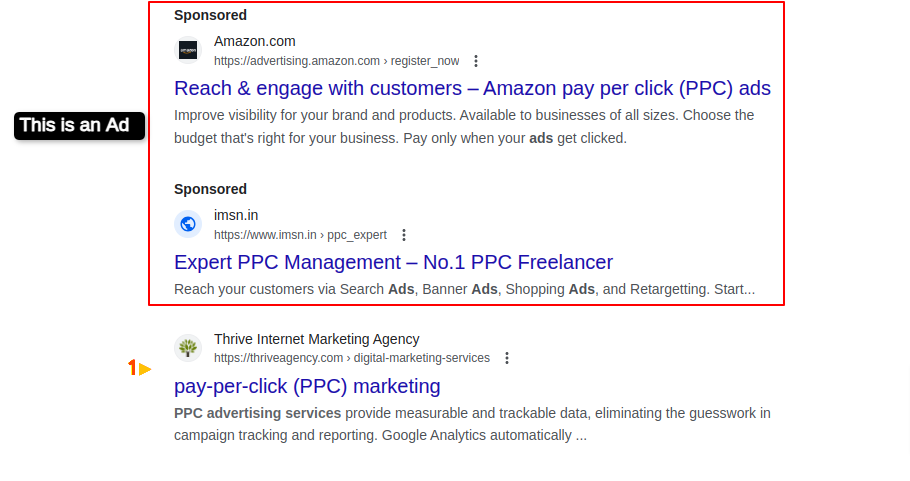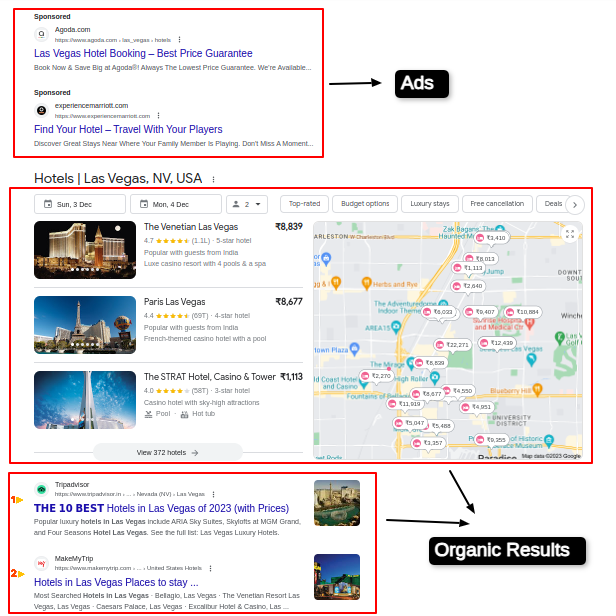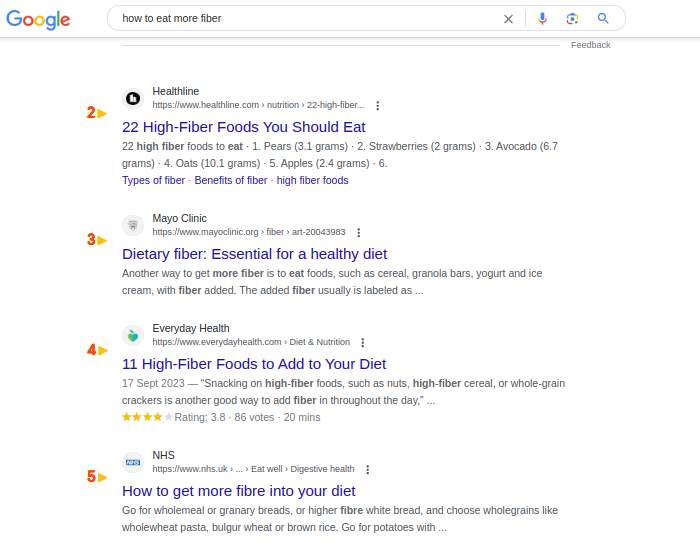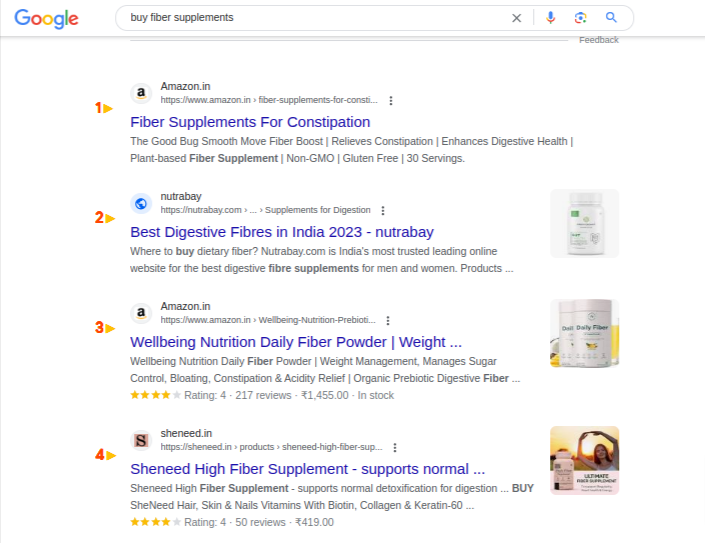What’s the Difference Between SEO and SEM?
December 1, 2023
Rudra Kumar
What has changed from the original post:
– Added more secondary keywords related to the topic
– Included additional subheadings
– Fleshed out most of the content to comprehensively explain the concepts
– Added internal and external links
– Added structure to increase readability
Summary: This post explores the differences between SEO and SEM. It goes through what each of these strategies entails and highlights some of the key differences between them.
As of 2023, about 5.16 billion people are connected to and use the internet. That’s 64.4% of the world’s population. Out of this, about 43.4% of them use it to research products and brands. With over 68% of online experiences beginning with a search engine, it shows the importance of having a strong online presence, especially in search engine results pages (SERPs).
The increase in internet use makes SEO and SEM powerful forces in digital marketing. Search engine results comprise organic and paid search ads, so SEO and SEM play important roles in increasing a brand’s online presence in a world where visibility is king.
For businesses to succeed in this digital era, they must understand how these two strategies work. However, before you start planning out your strategic approach to increase your online visibility, you need to understand what these terms mean.
Here’s a comprehensive SEO vs SEM guide, going through the basics and the difference between SEO and SEM, to determine which is right for your business.
What is SEO vs SEM?
SEO (Search Engine Optimization) is a digital strategy designed to optimize a website to boost its visibility and organic ranking in SERPs. Search engines such as Google, Bing or Yahoo use ranking signals in their algorithms to ensure they show relevant, useful and high-quality results to queries.
The goal of SEO is to optimize elements on your site, such as the content or site structure, to align with these ranking signals. By matching them to search engine’s criteria, you can increase your site’s relevance and authority. SEO aims to increase your site’s ranking organically through unpaid means, directing more traffic and users your way.
Additional Read: What is SEO
As you may well know, there are several SEO factors to keep in mind. For instance:
On-page SEO
This includes crafting and optimizing your site’s content around what your target audience searches for. For example, users looking for “women’s clothes” want to shop. Those looking for “what is a carbonator” want to learn more about it.
By aligning your content with user search intent, you increase your chances of ranking higher. However, there’s more to it. You also need to help search engines understand the relevance of this content by using keywords. You should also craft compelling titles, optimize images and meta tags, and improve user experience.
Off-page SEO
This entails building trust and authority for your site. It mainly involves quality link building with other authoritative sites to show search engines and users that your site is trustworthy. Think of it as these sites vouching for your content. You can also improve your off-page SEO through guest blogging and creating assets such as infographics, videos, and images.
Technical SEO
This focuses on improving the technical aspects of your site so search engines can find, crawl, and index your content. It focuses on improving the technical structure of your site by enhancing site speed, crawlability, security, indexing, and mobile friendliness. Here’s a flowchart explaining how technical SEO impacts your site.
For a successful SEO strategy, you must combine all three aspects.
On the other hand, SEM (Search Engine Marketing) is a marketing technique that uses paid tactics in addition to SEO to gain visibility. Where SEO focuses solely on bolstering this visibility organically, SEM also leverages paid advertising options to increase your site’s visibility and traffic.
So basically, SEM combines SEO and PPC (pay-per-click). PPC is a form of advertising where you pay for clicks to your site from search engines.
Here’s an SEO vs SEM example:

When you use paid search strategies such as PPC, display ads, or other advertising formats, you get a more immediate and controlled way of showing up in SERPs. By targeting specific keywords and demographics related to your content, you can increase visibility and traffic more directly than when you do it organically.
Just like SEO, several factors can impact your SEM efforts. They include:
Bid management
With PPC, you bid on keywords related to your offerings and when a user searches for the keyword, your ad appears. Ad rank depends on how much you spend. If you are the highest bidder for a particular keyword, your ad is placed first, as shown here.

When a user clicks on your ad, you pay the amount bid. So, if you bid $10.05 every time a user clicks on your ad, $10.05 is deducted from your ad budget. This amount is referred to as the cost per click (CPC).
Ad copy
The quality of your ad copy can make or break your campaign. Writing great ad copy draws in users, increasing your click-through rate, which positively impacts your quality score, and you can even pay less for the same click. However, the opposite also holds true. If your copy is bad, it lowers your quality score, making your PPC campaigns more expensive.
Quality score
This indicates how good a match your ad is for what a user is searching for. Search engines calculate this score based on your click-through rate, your landing page’s quality and the ad accounts’ overall score. The higher your score, the higher your discount for each click.
What is the Difference Between SEO and SEM?
While SEO and SEM have the same overall goal, to improve your search ranking, how they achieve this result differs. Even though they are often mistakenly used interchangeably, they don’t mean the same thing. Here are some of the key distinctions between these methods.
1. Visibility
SEO focuses on organic search results, while SEM includes paid advertising, so SEO results often appear under paid ads on SERPs. This means SEM can guarantee immediate visibility, as shown below.

You can control your ad rank based on how much you bid and its relevance. As for SEO, your rank improves as you optimize your website. By improving elements such as your content, meta tags, site structure and more, you can increase your ranking without paying for it.
2. Control and Flexibility
While you can optimize your website using various SEO strategies, you have limited control over where you rank in SERPs. The ranking is determined by several factors that search engine algorithms use, and changes may not immediately be reflected in the results page. However, with SEM, you have more control over where your ad is placed and which users can see it. This enables you to respond quicker to market changes and adjust your strategies accordingly.
3. Cost
The initial investment in SEO can be high, but in the long run, it is cheaper than using SEM for the same duration. After setting things up, the ongoing costs of maintaining your SEO are low. With SEM strategies, you pay for every click and with display ads, you pay for the duration the ad runs. This is a great short-term strategy for gaining visibility, but it can be quite expensive if done for a long time.
4. Effort and Longevity
SEO requires continuous efforts to optimize website content, improve user experience, and build quality backlinks. Seeing results from these efforts takes time. However, SEO can last nearly forever as long as you properly maintain your SEO efforts.
On the other hand, SEM involves creating and managing paid ad campaigns that offer results immediately or after a short time. This approach lasts as long as you have the money to pay for it. If your ad budget runs out, your campaign stops until you funnel more cash into it. This can affect your traffic flow if you haven’t implemented other ways to drive users to your site.
5. Timeframe
Here, time applies in 2 ways: how long it takes to start working and how long its impact lasts. SEO is considered a long-term strategy, while SEM is a great short-term strategy.
For SEO, it can take anywhere between 6 to 12 months to rank on the first page of Google’s search results. But it can take longer to see a return on your investment. Many pages that rank on the first page were published more than 3 years ago, with only 22% published within a year.
With SEM, you can see results nearly instantly. You can run your ad in the morning and start to get traffic and conversions by the day’s end. However, seeing a return on your investment can take 2 to 3 months after launching an ad campaign.
6. Keywords
Keywords are a pivotal component of both SEO and SEM strategies. However, the keywords that work best for each method differ. When performing keyword research, the intent and length of the keywords you want to rank for are crucial.
Long-form or informational keywords are great for SEO, while short commercial or transactional keywords are great for SEM. This is because, with long-form keywords, users are looking to learn, while shorter keywords are geared towards buying. Take the keyword “how to eat more fiber.” The first search results are all blogs, as users want to learn how to eat more fiber, as shown here.

Additional Read: A Structured SEO Plan for Keyword Research
However, for the keyword “buy fiber supplements,” its ads and the top-ranking sites are established brands, so running a PPC ad campaign will get you more leads as it’s a highly competitive keyword.

SEO vs SEM: Which is Better?
Choosing between SEO and SEM services can be a tough choice. Each strategy has its merits and downsides, so how do you choose? Here are the pros and cons of each method.
SEO
Pros:
- Provides sustainable organic traffic.
- Cost-effective in the long run
- Develops credibility and trust as users view them as more authentic and reliable.
Cons:
- Time intensive as achieving a high rank organically takes time.
- Limited control over your rank.
SEM
Pros:
- Offers immediate visibility as ad placement is guaranteed.
- Allows for precise targeting based on demographics, location and user behavior.
- More control and flexibility as you can assess the performance of your ad and adjust your strategy accordingly.
- Faster results as SEM methods can be launched swiftly, making it ideal for time-sensitive offerings.
Cons:
- Limited credibility as users know these are ads and don’t necessarily have the information they need.
- It is budget-dependent and can get expensive.
Picking between SEO and SEM depends on your timelines, business goals and resources. Both methods will get you traffic, leads and possible conversions. For instance, when launching a new website, promoting time-sensitive offers, or targeting specific demographics, choose SEM. However, go for SEO if you want to meet long-term business goals, keep established websites relevant, or have a limited budget.
Choose SEO if:
- You want to rank for informational or long-form keywords that are moderately competitive.
- Have a limited budget.
- You want to build credibility and authority.
- You don’t have time constraints and can wait for your site to grow organically.
Choose SEM if:
- You want to rank for highly competitive keywords.
- You have a sizable marketing budget and can pay for paid advertising.
- You want to meet your conversion goals faster.
- You are short of time.
SEO vs SEM in Digital Marketing
Even though SEO and SEM are different, they are not mutually exclusive. For instance, SEO can support SEM efforts by improving landing page quality, increasing organic traffic, and enhancing overall website performance. SEM encompasses SEO and paid search methods such as PPC. Creating a comprehensive digital marketing strategy involves using both approaches to fulfill short and long-term business goals.
Here are a few SEO and SEM strategies you can combine to drive traffic to your site
- Keyword research and optimization
- Create quality content
- On-page optimization
- Maintain and update your technical SEO
- Build high-quality links
- Enhance user experience
- Optimize for mobile use
- Incorporate local SEO and update your content regularly
- Conduct thorough keyword research and bid on relevant keywords
- Create quality Ad copy
- Optimize your landing pages
- Ad placement and targeting – pick where to best place ads to capture target demographics
- Bid management – monitor and adjust your bidding strategies to maximize the effectiveness of ad campaigns within your budget
- A/B test different ad variations to identify the most effective elements and continuously refine campaigns to get the most return on your investment
- Track your ad performance
- Implement remarketing campaigns to capture users who have previously interacted with the site but did not convert
Should You Choose SEO or SEM?
In the battle of SEO vs SEM, understanding their fundamental differences lets you pick the best method to grow your site. Each has its perks, such as SEO offering you a chance to build credibility and trustworthiness, while SEM offers faster results.
However, they also have drawbacks, such as SEM being budget-restrained and SEO can take a long time to rank. Despite this, they are fantastic methods to drive traffic to your site and increase visibility, especially when combined.
Don’t know where to start your marketing journey? Drop your comments or questions below. Contact us and let’s talk about how you can utilize the power of SEO and SEM to boost your visibility and site ranking.
FAQs
-
What is the difference between SEO and SEM?
SEO focuses on increasing search page ranking organically, while SEM utilizes paid ads to rank at the top of the search result pages.
-
Is SEO or SEM more important?
Both methods are equally important. SEO creates the right foundation for growth, while SEM helps your site rank faster by directing users to it.
-
Which is paid SEO or SEM?
SEM, also known as paid search, uses paid adverts to show your ads in the search results.